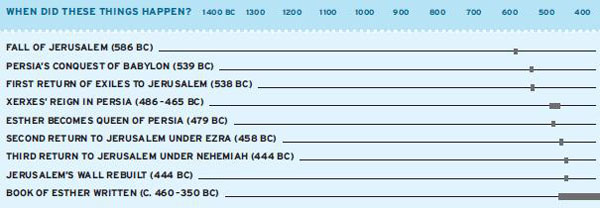Why read this book?
Have you ever wondered if God is really involved in the circumstances of your life? Do personal or political crises make you question God’s role in human events? The book of Esther, like much of the Bible, tells the story of God’s involvement with his people. Unlike the rest of the Bible, however, this book shows God’s work indirectly. In fact, God’s name is not mentioned once, nor is there any explicit reference to God, though his influence permeates the narrative. The book demonstrates how God worked in the lives of his people, and it will encourage you to trust him to work in your life today.
Who wrote this book?
The author is unknown, but it is clear from the book’s tone and details that the author was a devout Jew. Possibly Mordecai, Ezra or Nehemiah wrote it.
Why was it written?
It was written as a history of the events leading to the establishment of the Jewish observance of Purim (9:24–32), and as a way to assure God’s people (especially the Jews) of his protection.
When and where was it written?
In Persia, sometime between 460 and 350 BC. Esther became queen in 479 BC.
What to look for in Esther:
Look for revelations of God’s character—his faithfulness and how he provides for those who trust him, even through events you might view as tragic. Notice the indirect allusions to God’s involvement in the lives of his people (4:14, 16).
